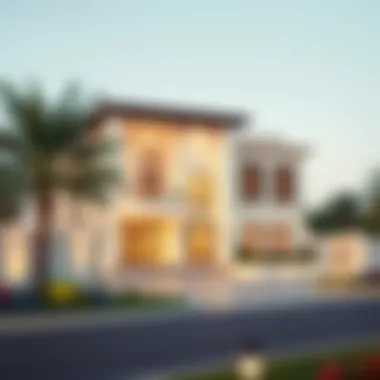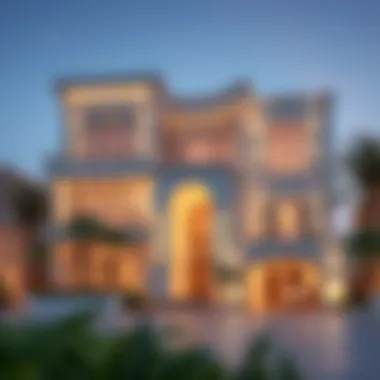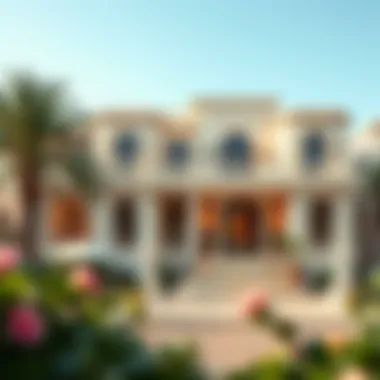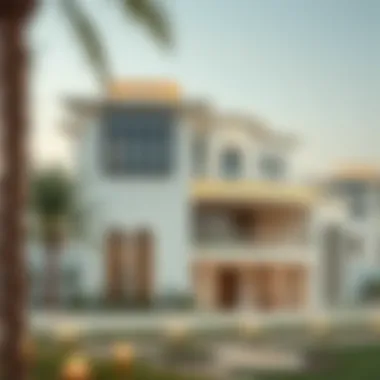Currency Conversion: 30,000 AED to USD Explained


Intro
Currency conversion can often feel like navigating a maze of numbers and rates. When you begin to explore how 30,000 AED translates to USD, it becomes more than simple arithmetic; it’s about understanding the broader economic landscape that influences these conversions. The ties between currency rates and real estate investments are significant, especially in locales like Dubai where the luxury market is booming. Being informed about these nuances not only helps travelers but also empowers investors keen on tapping into opportunities arising from fluctuating currencies.
In this guide, we will demystify the conversion of AED to USD, shedding light on the economic factors that determine exchange rates. We will touch upon the implications for investors looking at Dubai's opulent real estate sector, alongside current trends and local property features that can capture the interest of expatriates and homebuyers alike.
Understanding this conversion is critical, serving as the bedrock for informed decision-making in today’s globalized economy. The reader will be equipped with insights that transcend mere numbers, into the realms of investment strategies and lifestyle shifts within the UAE's ever-evolving real estate market.
Understanding Currency Values
In the realm of global finance, the term "currency values" often gets tossed around like confetti at a celebration. But what does it really mean? Understanding currency values is more than just knowing how many dollars one can get for their dirhams; it's about grasping the underlying forces that drive these numbers and how they impact individuals and businesses on multiple levels.
When diving into currency values, it’s essential to recognize that they reflect not just the current market sentiment, but also economic health, political stability, and even the overarching monetary policies of a nation. This understanding serves various audiences: real estate agents need to know current conversion rates for accurate property valuations, investors must gauge risks related to currency fluctuations, and expatriates often seek the best exchange rates for their day-to-day expenses. Even homebuyers looking into the Dubai market should be aware of how currency values can affect property prices and investment potential.
The benefits of understanding currency values extend far beyond mere math. They encompass strategic planning for investments, better budgeting for travelers, and making informed financial decisions based on currently available data. Not to mention, there’s a level of confidence that comes from knowing you’re not just another fish in a vast ocean of currency conversion, but someone who truly comprehends what's at stake.
To get a better handle on this topic, let’s break it down further in the upcoming sections.
Defining Currency Exchange
Currency exchange might seem boring or overly complicated at first glance. However, it’s a fundamental part of our economy. At its core, currency exchange is the process of converting one form of money into another. This exchange can occur at banks, currency exchanges, or even online platforms. The rates at which this conversion happens can vary widely based on several factors, including demand, supply, and geopolitical events.
Exchange rates are usually displayed in terms like “1 AED = 0.27 USD.” This means that for every one dirham, you would receive about twenty-seven cents in US dollars.
The fascinating part? These rates fluctuate continuously—like a rollercoaster that’s always in motion! What may seem like a small change can have far-reaching implications for businesses that import or export goods, as well as for travelers heading overseas.
Understanding AED and USD
The United Arab Emirates Dirham (AED) and the United States Dollar (USD) are more than just symbols of currency; they represent two vastly different economies. The AED is a stable currency, reflecting the prosperous and diverse economy of the UAE, heavily backed by oil and trade. It’s pegged to the USD, which provides it with a sense of strength and stability.
On the flip side, the USD is often seen as the world’s primary reserve currency. Its acceptance and circulation are unparalleled, which lends it a certain level of authority in global transactions. Because of this, fluctuations in the USD can significantly influence the dollar value of foreign currencies, including the AED. For example, a strong dollar may mean that you get fewer dirhams for your dollars, impacting purchasing power for both travelers and residents.
How Exchange Rates are Determined
Now, let’s get into the nitty-gritty of how exchange rates are determined—a complex mix that resembles a giant puzzle made of economics, geopolitics, and market psychology.
- Demand and Supply: The most straightforward concept. If there's high demand for a currency, its value will rise. Conversely, if a currency floods the market without corresponding demand, it'll lose its value. The simple laws of supply and demand establish the base level.
- Interest Rates: A vital economic tool, central banks can affect currency values by altering interest rates. Higher rates typically attract foreign capital, increasing the currency's value as investors seek better returns.
- Speculation: Market participants often try to predict movements in currencies, which contributes to volatility. If traders believe the AED will strengthen against the USD, they may stock up on dirhams, driving up the price.
- Economic Indicators: Reports on employment, inflation, and GDP growth give insights into economic health. A thriving economy usually lends strength to its currency, while negative data can weaken it.
This mixed bag of factors underscores why a deep understanding of exchange rates is crucial in today’s interconnected world. For example, knowing how these rates can shift teaches a traveler not to change all their money at once but to keep an eye on trends.
Through these foundational concepts of currency conversion and comprehension, readers will be better equipped to navigate the financial waters ahead. Understanding currency values forms the backbone of smarter financial decisions, especially for anyone interested in investing in markets like Dubai's luxury real estate.
Current Exchange Rate Landscape
Understanding the current exchange rate landscape is crucial for anyone dealing with currency conversion, especially for those considering converting 30,000 AED to USD. The exchange rate isn't just a number; it reflects the economic interplay between different countries' currencies. Fluctuations in these rates can have profound consequences on transactions, investments, and future economic planning.


In the context of 30,000 AED being translated into USD, knowing the recent landscape can help investors, expatriates, and travelers make informed decisions. The significance of these rates extends beyond day-to-day purchases; they influence long-term financial strategies and expectations in the real estate market of Dubai.
Overview of Present Exchange Rates
The present exchange rates serve as a barometer of economic health between the United Arab Emirates and the United States. For instance, if the current exchange rate is around 0.27 USD for every AED, then 30,000 AED would equate to roughly 8,100 USD. However, this figure is fluid. Factors such as inflation rates, interest rates, and geopolitical stability can dramatically alter these rates in a very short time.
- Recent trends in exchange rates are often influenced by:
- Economic reports from central banks
- Political developments impacting investor confidence
- Global economic indicators such as oil prices and trade balance
Historical Data and Trends
Examining historical data can reveal patterns that inform future expectations. Historically, the UAE Dirham has maintained a relatively stable peg to the US Dollar. This stability is advantageous for those involved in international trade and investment. However, analyzing past fluctuations, such as during economic downturns or periods of market speculation, can provide valuable insights.
For instance, during the 2008 financial crisis, exchange rates saw significant shifts, and many investors adapted their strategies based on past performance. Keeping an eye on these trends helps potential investors in the Dubai real estate market to understand when it might be best to enter or adjust their holdings.
Predicting Future Trends
While no one has a crystal ball, certain indicators can assist in forecasting future trends in exchange rates. Analysts often look at economic indicators, such as GDP growth rates and employment statistics, which can influence currency strength.
For those calculating the conversion of AED to USD, understanding future trends could mean:
- Planning investments ahead of favorable exchange rates
- Timing transactions to minimize losses during unfavorable rates
- Leveraging information for strategic currency investments
Taking a proactive approach based on sound predictions allows individuals to navigate the often unpredictable financial sea safely and effectively.
"In currency conversion, a stitch in time saves nine. Understanding the past paves the way for better financial decisions in the future."
Navigating the maze of exchange rates not only assists in personal finance but opens wider opportunities in global marketplaces. While 30,000 AED may seem straightforward today, a comprehensive understanding of the current landscape equips one for future endeavors.
Conversion Insights for , AED to USD
Understanding the nuances of currency conversion, particularly for translating 30,000 AED into USD, is crucial for various stakeholders, especially in the dynamic real estate market of Dubai. The forex landscape can be quite the labyrinth if one isn't familiar with its twists and turns. Grasping these insights not only sheds light on current market situations but also helps investors, expatriates, and homebuyers navigate their financial decisions more effectively.
With currency values fluctuating based on a multitude of factors, knowing the conversion insights gives a clearer picture of one’s purchasing power. This understanding is essential when contemplating investments in properties, traveling, or even handling business transactions along the vast and vibrant markets of the UAE. This segment elucidates the current conversion value, focusing on the precise exchange rate for 30,000 AED to USD, while also examining key factors that sway these rates, from economic indicators to geopolitical happenings.
Current Conversion Value
As it stands, the conversion from 30,000 AED to USD yields a significant figure that carefully influences spending capabilities. The conversion value hinges directly on current forex rates, which fluctuate minute by minute. For clarity’s sake, this amount translates approximately to around $8,150 USD at recent exchange rates. However, this value can see adjustments based upon market conditions.
For those engaging in transactions or investments, it becomes imperative to check for the most relevant and updated figures. Converting currency isn’t merely about crunching numbers; it’s about understanding the implications of those numbers.
To get the latest and most accurate exchange rates, platforms like XE and OANDA are highly recommended.
This fluidity in rates can have immediate effects on purchasing power, especially in high-stakes environments like real estate, where even a minor shift can lead to substantial monetary implications.
Factors Influencing Conversion Rates


Several elements drive the ebbs and flows of conversion rates. Understanding these factors can equip stakeholders with the foresight needed for sound decision-making. Here’s a breakdown of the primary influences:
- Economic Indicators: Inflation, GDP growth, and employment rates in both the UAE and the US play a major role. A resilient economy typically strengthens the local currency against others.
- Monetary Policies: Interest rates dictated by the central banks in both nations can sway currency values. When rates go up, it often attracts foreign investment, boosting that currency’s appeal.
- Geopolitical Stability: Political events or instability can spook investors, leading to currency depreciation. The peace of mind regarding a country’s stability assists in bolstering the strength of its currency.
- Market Sentiment: Whether investors are bullish or bearish can dictate currency trends. Speculators in forex markets can drive up demand for a currency simply based on speculation.
In summary, understanding the current conversion value and factors influencing rates provides the necessary insights for informed decisions. The considerations highlighted help frame context for potential investors in Dubai’s real estate market, enabling them to leverage currency conversion for maximizing returns.
Practical Applications of Currency Conversion
In today’s increasingly interconnected world, understanding currency conversion is a skill that goes beyond mere arithmetic. It influences the decisions of travelers, investors, and even individuals planning for future financial security. With 30,000 AED translating to USD, the practical applications of this conversion are manifold and resonate across various sectors. Knowing how to navigate currency fluctuations provides a clearer picture for those engaging in international transactions or investments.
Implications for Travelers
For travelers, the implications of currency conversion extend beyond just knowing how much money they can spend. It shapes budgeting strategies and influences spending behavior abroad. When traveling from regions like the UAE to the US, for example, a fluctuating exchange rate can dramatically alter the purchasing power of one’s funds.
- Budgeting: Having a clear understanding of the current conversion rate aids travelers in budgeting their expenses. Knowing that 30,000 AED roughly translates to around $8,200, they can plan their itinerary without overspending or undershooting their financial capabilities.
- Shopping and Dining: Currency variations can affect prices. A traveler might face higher prices in tourist areas where conversion rates are less favorable. Thus, converting money wisely can lead to better deals and experiences.
Travelers not only benefit in terms of spending but also in terms of financial security. Carrying cash in a foreign currency exposes one to the risks of theft or loss. Hence, understanding which conversion methods offer the best rates can help mitigate financial risks, allowing individuals to focus on the experience rather than worry about their funds.
Impact on Real Estate Investors
The landscape of real estate investment in Dubai, particularly for foreign investors, heavily relies on understanding currency conversion. For expatriates or international buyers looking to invest in luxurious properties, the conversion factor can mark the difference between a good deal and a poor one.
- Market Entry Costs: Investors must know how the conversion from AED to USD affects property prices. If the USD strengthens against the AED, properties that once seemed affordable could suddenly become beyond reach.
- Property Valuation: The valuation of properties might look enticing when viewed through AED, but vigilance on currency values is vital to ensure that investments translate well in their home currencies.
- Long-Term Considerations: It is also essential for these investors to consider future conversion rates. Will their investment appreciate or depreciate in their own currency? Awareness of global economic trends can give an investor an edge in decision-making.
"Investing in real estate isn't just about the property; it's about making financial decisions that will yield returns in your currency."
Managing Currency Risk
Currency risk is a real concern for anyone engaging in international transactions. Fluctuations in exchange rates can lead to unexpected losses, particularly when converting large sums like 30,000 AED to USD. However, there are strategies to manage this risk, ensuring a smoother financial experience.
- Hedging: Investors often use hedging strategies to lock in exchange rates. By doing so, they can stabilize costs regardless of fluctuations in currency. Financial instruments like forward contracts may come into play, allowing an investor to set a price for future conversions.
- Diversification: Spreading investments across various currencies and markets can help mitigate the impact of any sudden devaluation or appreciation. If one currency takes a hit, having assets in another can offset potential losses.
- Regular Monitoring: Keeping an eye on conversion rates and economic indicators is crucial. Being proactive rather than reactive can save significant sums in the long run. Currency conversion apps and financial advice from those in the know can prove invaluable for making timely decisions.
Understanding these practical applications of currency conversion isn’t just beneficial; it’s essential for anyone engaging on the global stage, whether for travel, investment, or financial security. The ability to navigate these waters can yield benefits that extend far beyond a single transaction.
Exploring Dubai's Real Estate Market
Investigating the real estate landscape in Dubai forms a central piece of the puzzle for anyone considering investments, especially when translating funds like 30,000 AED into USD. This vibrant market offers exotic opportunities shaped by a blend of luxury and practicality. With a unique combination of modern architecture, strategic location, and the governance that supports international investments, the Dubai real estate sector is an intriguing place for both seasoned investors and newcomers.
Overview of Luxury Properties
Dubai stands as a beacon of luxury properties that dazzle with high-end amenities and stunning designs. The skyline is peppered with extravagant buildings such as Burj Khalifa and Palace Beach Residence that not only attract attention but also showcase the financial potential within the market. As an investor, knowing the types of properties that are on offer is essential.
In recent years, the market has seen a surge in developments catering to affluent buyers. Here are some notable types of luxury properties:
- Villas and Mansions: Spacious homes often located in communities like Emirates Hills and Palm Jumeirah. These properties reflect opulent living with private pools and landscaped gardens.
- High-rise apartments: Standing tall in coveted areas like Dubai Marina and Downtown Dubai, these apartments offer spectacular city and sea views, facilitating a lifestyle of comfort and elegance.
- Commercial properties: Often attractive for investors seeking rental income, commercial spaces in places like Business Bay and Jumeirah can offer high returns, especially given the global business allure of Dubai.
It’s essential to keep an eye on the vacancy rates within these luxury segments to gauge future opportunities. The price stability across such properties often reflects the larger market trends, making them an interesting focal point for investors.


Market Trends and Future Outlook
The real estate market in Dubai is a moving target, where trends evolve swiftly based on both local dynamics and global economic factors. Recent observations indicate a recovery trajectory in the market, driven by factors such as an influx of expatriates and burgeoning tourism, all serving to push demand upwards.
For instance, property values in areas rich in amenities and cultural experiences have shown resilience. Here’s how the landscape looks:
- Post-COVID Recovery: The pandemic has reshaped many facets of living and working in Dubai, with increased demand for spacious homes fueling prices in suburban areas. People are seeking properties that accommodate both leisure and workplace capabilities as remote work continues to gain traction.
- Sustainability Trends: Growing awareness regarding environmental responsibility is leading to a rise in demand for green buildings, which are not only appealing but also aligned with government initiatives targeting sustainability. Investing in properties that echo this ethos could yield long-term benefits in desirability and valuation.
- Influx of Foreign Investment: As Dubai maintains its status as a global business hub, international interest in property investments remains strong. Regulatory changes have made it easier for expatriates to purchase homes, leading to bullish expectations for various property segments.
As Dubai continues to attract global attention, understanding the market trends becomes paramount for savvy investors seeking to leverage opportunities.
Informed Investing in Dubai
Investing in Dubai's property market can be a lucrative endeavor, especially amid its fast-paced growth and vibrant economy. However, to navigate effectively through this landscape, it's crucial for investors to arm themselves with knowledge. This section explores the concept of informed investing in Dubai, focusing on specific elements, benefits, and considerations necessary for anyone looking to make a sound investment in real estate here.
Understanding Property Valuation
In the intricate world of real estate, understanding property valuation serves as the foundation for making informed decisions. Property valuation in Dubai involves assessing various aspects that influence worth.
- Market Trends: Staying attuned to current market dynamics is vital. Analyzing how properties in different areas have appreciated over time provides insight into potential investment value. For instance, luxury properties in Palm Jumeirah will typically command higher prices than other locales, driven by demand and desirability.
- Comparable Sales: A thorough investigation into comparable properties recently sold in the vicinity can shed light on reasonable price expectations. Analyzing these sales helps investors gauge a property’s value relative to the market conditions.
- Location Factors: Key to property valuation are the location and its surrounding amenities. Proximity to vibrant business districts, transport links, and community facilities can drastically affect a property's appeal and, consequently, its valuation.
"A smart investor doesn’t just look at numbers but also sees the potential behind them."
- Economic Indicators: Understanding local economic indicators, such as employment rates and foreign investments, can also impact property valuations. A thriving economy typically correlates with rising property prices, making knowledge of these trends essential for savvy investors.
Evaluating Neighborhood Potential
Selecting the right neighborhood can make or break your investment in Dubai. Evaluating neighborhood potential involves assessing various elements that influence long-term value and livability.
- Infrastructure Developments: Upcoming infrastructure projects, like new metro lines or commercial hubs, often signal growth. Future developments can enhance a neighborhood's desirability, contributing to increased property values.
- Community Services: Quality schools, hospitals, and recreational facilities can significantly impact the attractiveness of a neighborhood. Families often prioritize these elements, making areas with robust community services more appealing for homebuyers.
- Demographics and Trends: Understanding the demographics of a potential neighborhood can guide investment decisions. Areas with a diverse population that attracts expatriates and young professionals tend to foster vibrant communities with steady demand for housing.
- Safety and Environment: Safety is a paramount concern for many homebuyers. Researching the crime rates and overall environment of neighborhoods can help investors choose areas that will attract buyers looking for a secure living space.
Investing in Dubai’s real estate requires more than just financial considerations. Knowledge is power. By focusing on property valuation and neighborhood potential, investors can better position themselves for success in this ever-evolving market.
Concluding Thoughts
As we wrap things up, it’s crucial to spotlight the significance of understanding currency dynamics in today’s global economy. Currency conversion isn’t just a mathematical exercise; it embodies the interplay of economic indicators, global politics, and individual ambitions. When it comes to converting 30,000 AED to USD, the implications stretch far beyond mere numbers.
The Importance of Currency Knowledge
Currency knowledge serves as a compass for anyone engaging in international transactions. For travelers, a good grasp of currency exchange can spell the difference between getting the most bang for your buck and regretting overspending. Investors, particularly those eyeing the luxurious Dubai real estate market, need to be astute in understanding how currency fluctuations may affect their portfolio and purchasing power. In essence, having a handle on currencies allows individuals to make informed decisions, avoiding unnecessary risks that can cost dearly.
"A little knowledge is a dangerous thing, but a lot can go a long way toward making savvy financial moves."
This understanding also extends to expats and foreigners living in the UAE, where adaptation to local financial realities is paramount. Keeping up with fluctuations in the AED/USD exchange rate ensures they manage their finances effectively, safeguarding against economic instability.
Final Considerations for Investors
Investors must not only consider current exchange rates but also think about potential shifts that might arise from economic indicators, geopolitical events, or regional instability. While the allure of Dubai’s luxury properties can be tempting, a miscalculation in currency conversion can significantly impact profitability.
Here are a few final takeaways:
- Monitor Exchange Rates: Regularly check the updates on the AED to USD conversion, as these rates fluctuate daily based on market conditions.
- Consult Experts: Engage with financial advisors familiar with currency markets. They can provide insights tailored to your specific investment goals.
- Diversify Investments: Don't put all your eggs in one basket. Consider diversifying your investments across various currencies to mitigate risk.
Gaining insight into conversion practices and the broader implications of currency is vital for anyone wishing to thrive in international markets. Real estate agents, expatriates, and investors alike should treat currency knowledge as an essential tool in their financial toolkit.



